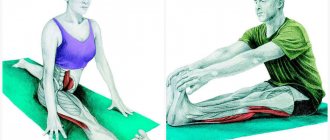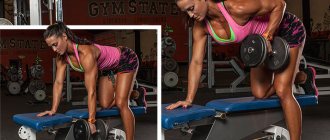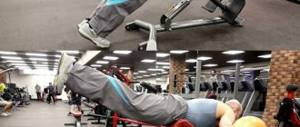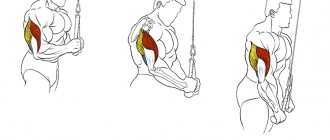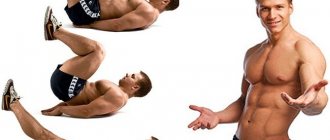Pull-ups are a popular exercise that involves lifting your body by bending your arms and thus counteracting the force of gravity. It is performed on a horizontal bar - a universal machine for working out different muscle groups. There are different variations of pull-ups, which shift the load on certain muscle groups. You need to know which muscles work when doing a pull-up, and how to work different groups by changing the technique.
Differences in execution technique
Being a simple design, the horizontal bar allows you to pump most muscles at home, performing exercises of varying complexity. All exercises can be divided depending on the grip on the horizontal bar with your hands. By changing the position of your hands when doing pull-ups, you include certain muscle groups in the work. We must not forget about the width of the grip, that is, the distance between the hands. The quality of the load on the muscles will depend on this.
The result obtained also depends on the point of contact of the body with the horizontal bar. A standard pull-up at home involves touching the bar with your chest. Thanks to this, the load is distributed evenly, and all the back muscles are involved. If pull-ups are needed to gain muscle mass, then you need to quickly lift the body and slowly lower it. For muscular endurance, you need to rise slowly and lower your body quickly.
Training program
Before you begin creating a training program, you need to determine what goals you are pursuing. In my opinion, there are two main ones:
1. Increasing the number of pull-ups.
2. Increased muscle mass.
One way or another, they are interconnected, but there are certain features of the execution technique for the first and second options. If you want to do a lot of pull-ups, then you need to strive to conserve energy and include as many muscle groups as possible. If you want to get a wide back, you need to perform repetitions in a style in which the latissimus dorsi muscles will be maximally loaded.
I will write more about the programs, stay tuned!
Medium Grip Pull-Up
Ideal for beginners! This type of pull-up is not only easy, but also effective. It can be used to train the biceps and lats, as well as the shoulder, pectoral and trapezius muscles. The abdominal area also takes part during the process of pulling up in this way.
Technique:
- Your hands should be positioned shoulder-width apart, the bar should be grasped from below, and your back should be concave.
- You need to take a deep breath and begin to tighten your body and try to bring your shoulder blades together. When pulling up, you should strive to touch the bar with your chest or chin.
- When the body position reaches its maximum, you should hold for a few seconds and lower down. The legs can be crossed, but they should not dangle or jerk in different directions.
- When the body is lowered down, the arms should be fully straightened. This pull-up should be repeated as many times as possible.
Medium overhand pull-up
This type of pull-up is popular when the important indicator is the number of repetitions, i.e. work on muscle endurance! Pull-ups in this way help to train several muscle groups: biceps, shoulder muscles, chest and back muscles, as well as the abs.
Technique:
- A pull-up is performed using a medium overhand grip as follows. Hands should be positioned on the bar at shoulder width. The palms are in the opposite direction from the face, that is, the hands should be placed on the bar from above.
- The back should be slightly concave. You need to lift your body while inhaling, and when returning to the previous position, exhale, straightening your arms.
- When doing pull-ups, you need to reach for the bar to touch it with at least your chin and maximum with your chest. The exercise should not be performed abruptly; the legs can be crossed.
Pull-ups on the horizontal bar
Hello to everyone who cares about how he looks and who cares about his health. Today we will talk about what types of pull-ups on the horizontal bar exist. This information will help you correctly approach each exercise, and, therefore, correctly work the desired muscle group. Professional athletes recommend starting with something simple, because, despite the fact that the horizontal bar is a fairly simple piece of equipment, exercising on it is not so easy.
Types of pull-ups
The most basic type is the basic exercise. It and its benefits have already been discussed in previous articles, so we will not dwell on this type and will move on. Those who want to know more about it can read a separate article dedicated to this method. It’s worth saying right away that there are a lot of ways to pull up. With their help, you can work out a variety of muscles in the body, for example, biceps, chest muscles, trapezius, triceps and so on.
There are several classifications of pull-ups.
1. According to the method of gripping the crossbar, there are three types: upper or direct, lower or reverse, and opposite. - upper grip, position of the hands on top of the crossbar; - lower grip, position of the hands from below the crossbar; - opposite, when one hand is located on top of the crossbar, and the other - below.
Each of the listed types involves a different load. For example, if you want to work the muscles on your back, then give preference to a straight or standard grip. If your goal is biceps, then perform the exercises with an opposite grip. A different grip will help connect the shoulder muscles and biceps. Just remember to change the position of your hands.
2. The next type involves different hand positions, that is, grip width. Narrow, hands are located as close to each other as possible. In this exercise the main emphasis is on the work of the hands; Medium – hands are located approximately shoulder width apart. In this case, the load is directed to the muscles of the arms and back and is carried out evenly; Wide grip - load on the “wings” and back muscles, arms are positioned as wide as possible. This classification affects not only the working muscle group, but also the degree of intensity of the exercise. The smaller the amplitude, the lower the load and vice versa. The maximum load is achieved when performing pull-ups with a narrow grip.
3. The following classification involves different points of contact with the crossbar. Standard – when you need to reach the bar with your chest. In this case, the load is carried out evenly, and all the broad muscles of the back are worked out. Reverse – when you need to reach the crossbar with your neck area. In this case, the upper body is actively worked out.
4. The cleanliness of pull-ups also has its own classification. For example, this could be slow and smooth raising and lowering of the body, the so-called clean pull-ups. In addition, there are pull-ups with swinging, when the body rises sharply, and pull-ups with incomplete extension of the arms at the elbow joint.
5. And the last division of exercises is based on effectiveness. For the maximum amount, exercises must be performed according to the following scheme - the ascent should be slow and the descent should be fast. And if you want to gain body weight, then this scheme must be performed in reverse.
And now it’s time to talk directly about the types of pull-ups. Each of them is pleasant in its own way and has a number of features that we will definitely tell you about.
Option No. 1 – Classic This option is the most popular and is very popular not only among beginners, but also among world-famous athletes. The basic position is as follows: the grip should be slightly wider than shoulder width. First you need to perform one lift from the bottom position. In this case, the main emphasis should be on the muscles of the arms and back. A repetition is counted only when the chin crosses the level of the crossbar.
Option No. 2 – Neutral If we consider this option from the point of view of the load on the joints, this option is the safest. With this grip you can effectively work out the upper torso. By performing exercises in this way, you can not be afraid of damaging the shoulder joints and avoid injuries in the shoulder area. The peculiarity of this grip is in the position of the hands, palms should be directed towards each other. This is possible if the horizontal bar is equipped with additional handrails located perpendicular to the main crossbar.
Option No. 3 – Supinated This method is based on supination of the biceps, which is a rotation to the outside. This option is perfect for those who dream of massive biceps; such exercises should definitely be included in the main training program. Thanks to the supinated method, the biceps tendons experience enormous stress, so it is worth foreseeing the possibility of injury in advance. To avoid this, you must try to prevent the body from slowly lowering, hanging in the air and actively lifting.
Option No. 4 – Combined This method is the following grip: one hand is in the standard position, and the other is in the opposite position. This option significantly increases the grip between you and the bar, which in turn allows you to increase the number of repetitions or increase the intensity of the workout due to additional weights. You can use any additional weight as a burden, for example, by tying it to your belt.
Option No. 5 - Gironda Method These chest pull-ups got their name in honor of one of the bodybuilders who came up with this method. In order to perform these exercises at full strength, a person must be physically prepared and developed, since such an exercise involves a fairly large range of action. Before each movement, hover slightly in the lower position. The peculiarity of this method is that it is not the upper part of the sternum that is pulled to the crossbar, but its central part. If you perform the movements using a supinated grip, it will be relatively easier to achieve results.
Option No. 6 – Transverse pull-up Many athletes perceive this exercise as one of the most fun and interesting, since when performing it the body is in two planes at once. Initially, you need to take a position strictly perpendicular to the crossbar. Grasping the bar with your hands, move your hands so that there is some free space between them. While in this position, you must simultaneously pull yourself up and turn your body 90 degrees. Each time you climb, you should change the direction of the turn. This exercise is characterized by a feeling of tension in the abs and buttocks. Usually it is the final one in the training. With this exercise you will not only strengthen your shoulder girdle, but also make your body much stronger.
Option #7 – Half-Moon This type of pull-up is better known as “Half Moon”. Compared to other methods, it appeared relatively recently. With its help, you can well prepare your body for more serious loads, such as one-arm pull-ups. This exercise can be performed with any grip, but experienced athletes recommend pronation and the neutral method. In order to start pulling up, you need to grab the bar and fully extend your arms. After which the body must be pulled alternately to one or the other hand. It is important not to stop; try to move smoothly from one hand to the other, while returning to the starting position each time.
This is where the most traditional options end, and we continue to consider more exotic methods of pulling up on a bar.
Option #8 – Hand-swithes Correct execution of this exercise will allow you to develop the ability to grab and release. In addition, with its help you will develop the explosive power of lifting the body, because all movements must be performed with maximum power.
Option No. 9 – Pull-ups using a rope This pull-up is performed using a rope thrown over the handles of the crossbar. Do not think that this is easy, because the grip area is much smaller, and therefore it is much harder for the athlete to pull himself up. By replacing the fulcrum, you can use small muscles that are not worked in standard variations, which in itself is very useful.
Option #10 – Flip Hand grip Pulling up and simultaneously turning your arms develops grip and trains your hands. With each subsequent lift, your task is to rotate your hands one by one, changing your grip.
Option No. 11 – Pull-ups using additional devices To perform this exercise, you will need a belt or rope that should be thrown over the bar. Your task is to hold on to the bar with one hand and grab the device with the other. This will increase your grip strength and improve your grip. If you want to strengthen your stability with the crossbar, then you should pay attention to the following exercises.
Option No. 12 – Moving the body This method involves influencing the stability of the position of your body from the side. This exercise should be performed in pairs. While you are lifting to the bar, your partner is trying to move your body to the side. At the same time, you must tense your body as much as possible and prevent the process of moving your body. Another variation of this exercise is for your partner to try not to push your body, but to pull it towards him. To do this, you must first tie a rope or belt around your waist, leaving a small margin for more convenient execution of the exercise. Remember that the push or pull does not have to be strong enough, a little unbalance will be enough.
Option #13 While hovering at the top point, add leg movement. The good thing about this exercise is that it develops and strengthens your body by simultaneously stretching your upper torso and stabilizing your lower torso.
After some time, you will notice that you can hang on the horizontal bar longer, and your coordination has become much better. The pull-ups of many beginners often resemble convulsions, since their movements are not coordinated. To regulate the process, you should give preference to these two techniques. Nobody forbids you to show your imagination and come up with your own ways of doing pull-ups that you can do. After things get better, you can move to the next level and try more complex options. We tried to list the most basic and most productive ways to do pull-ups. Start with the simplest ones and gradually move to the next level. And finally
Good physical shape is the destiny of every person! There is no limit to perfection, practice yourself and achieve results. And we, for our part, will try to make your training as useful and effective as possible. Someone may say that horizontal bars / parallel bars are just a useless piece of hardware, but after reading our article, he will definitely change his mind. After all, as you have already seen, there are a huge number of types of pull-ups on the horizontal bar. Remember, as one of the smart people said, everything ingenious is simple! This is exactly the case.
Wide overhand pull-up
A wide grip helps train the trapezius and upper muscles, the shoulders, as well as the teres muscle and biceps. To increase muscle mass faster, you can add additional load to the belt. But before you add weight, first master the correct technique. As soon as you can technically do 10 pull-ups with your own weight, feel free to add weights!
Technique:
- Your hands should be positioned 25 cm wider than your shoulders, your hands should grab the bar of the horizontal bar from above, your back should be concave.
- This type of exercise is somewhat reminiscent of the medium overhand pull-up technique, but there are slight differences. The arms in this exercise are the main support, which are the “hooks”.
- Raising the body occurs due to tension of the latissimus muscles. When the body is at the top point, the elbows are strictly directed downward.
What muscles work when doing a pull-up?
The pull-up is one of the best all-around exercises for building muscle, improving strength and endurance. During its execution, a person takes hold of the horizontal bar bar and hangs on his straight arms. Then, by bending the elbows, the body rises up until the arms are completely bent. You need your chin to rise above the bar and the bar to be at shoulder level. At the same time, the muscles of the shoulders and back are fully involved when pulling up, and therefore develop harmoniously.
Pulling up is a natural movement for humans. It is safe from the point of view of natural biomechanics, since it does not injure the spine, but, on the contrary, strengthens and stretches it. Regular training with alternating different exercise variations remarkably strengthens the muscle corset.
Let's look at which muscles swing when doing pull-ups on the horizontal bar:
- Back muscles: latissimus, teres, trapezius, rhomboid, as well as a number of small ones.
- Arm muscles: biceps, brachioradialis, brachialis, forearm flexors and extensors and other small muscles.
- Abdominal muscles (act as stabilizers): rectus muscle, oblique, transverse muscles.
- Rear delts.
- The triceps and pectoral muscles work as assistants.
Which muscles work when doing pull-ups on the horizontal bar will depend on the technique used to perform the exercise.
Close grip pull-up
With a close grip, you can do pull-ups using the lower or upper hand placement method. Regardless of what grip you use, you need to perform the exercise the same way. When performing this type of pull-up, the arms are most involved. During the lower narrow grip, the biceps are trained, and in the case of the upper grip, the back muscles.
Technique:
- Your arms should be narrower than your shoulders. The distance between the hands on the crossbar should be approximately 20 cm.
- You need to take a breath and begin to smoothly lift your body, try to touch the bar with your chest. But this will be difficult to do.
- When the body has reached its maximum point, you need to start lowering it down smoothly and exhale.
Pull-up along the bar
This exercise trains the lower latissimus and brachialis, as well as the serratus muscles. You need to perform this type of pull-up while standing with your side to the bar or under it. That is, during pull-ups, the crossbar will not be across the body, but along it.
Technique:
- You should clasp the crossbar with your hands so that they are one after the other. When performing pull-ups, you need to bend your back so that the maximum load on the muscles occurs.
- When the body is raised, the head will be to the side of the horizontal bar. You should pull yourself up so that your head changes its position in different directions. To perform this exercise at home, the horizontal bar should be located close to the ceiling.
Insurance and assistance
Despite the fact that the presence of an assistant in pull-ups is, in general, not absolutely necessary, it can nevertheless be useful. When your repetition stalls and there are only a few centimeters left before your chest touches the bar, an assistant can help you complete the repetition. By holding your back with both hands, he can help you pull yourself up to the end. The assistant's force should be directed upward, along your normal trajectory. If the assistant pushes you forward rather than upward, he will simply ruin your repetition.
One-arm pull-up
This is the most difficult type of pull-up, especially for beginners. First, you need to master overhand grip pull-ups 10 times. And only then try your hand at one-arm pull-ups.
Technique:
- Initially, you need to pull yourself up with both hands, but at the moment of lowering down, you need to release one hand. At first it will be possible to lower your body quite quickly. But gradually the muscles will begin to strengthen and allow you to descend smoothly and slowly.
- When pulling up and down as effectively as possible, the chin will be close to the hand.
- To avoid pain in the elbow joint, the load should be carried out gradually. During the exercise, the arm should not be completely straightened, and the shoulders should be kept tense.
Friends, support our group on Facebook, share this post with your friends or click the “Like” button! and you will always be aware of the latest news from the “Duty Rocking Chair”!
For you, we collect the best workouts, recommendations for proper nutrition and, of course, humor from the world of beautiful, energetic and healthy people - like you and me!
Source
A little about the correct technique
In order for the muscles to be worked as efficiently as possible when doing pull-ups, you need to perform the exercise correctly. One of the main mistakes beginners make is not completing the exercise completely. When we say a “full” pull-up, we mean that when the highest point is reached, the collarbone should be at the level of the bar. There is no need to bend, throw your head back or tilt it forward.
When you reach the bottom, straighten your arm completely, then pause for a second and move up again.
Proper breathing technique is important. Do not hold your breath, breathe freely, but it is better to rise as you exhale, and to descend as you inhale.
Please note that when doing pull-ups, the arm muscles always work, but the lats only work when lifting from the bottom position. If you limit the amplitude and do not perform all stages of the exercise, then the back muscles will practically not take part in this process, and accordingly, it will not train either.
You may not be able to do a full pull-up at first. In this case, you can lower the horizontal bar lower (if possible) and push off with your feet, helping yourself to reach the top point. Try to lower your body as smoothly and slowly as possible until your arms straighten.
Another important point: no need to chase quantity. For beginners, it is better to do three pull-ups with perfect technique than twenty times, but absolutely incorrectly. You can master the exercise technique on a counterweight machine. Then you can start with push-ups with a reverse grip, which are considered the easiest, and then move on to a direct grip, varying its width. Then you can use weights. It will also be useful to supplement pull-ups on the bar with block rows on a special machine - this will help increase the effectiveness of your training.
For optimal muscle development, it is recommended to perform pull-ups 3-4 times a week . It is not advisable to exercise every day, as the muscles get used to the load. In addition, they need time to recover in order for them to actively grow. In general, pulling up on a horizontal bar, which muscles are pumped when doing it, you already know, is an excellent exercise that, when performed with the correct technique, is really effective. Alternate different types of pull-ups, and then you will be able to achieve harmonious muscle development.
